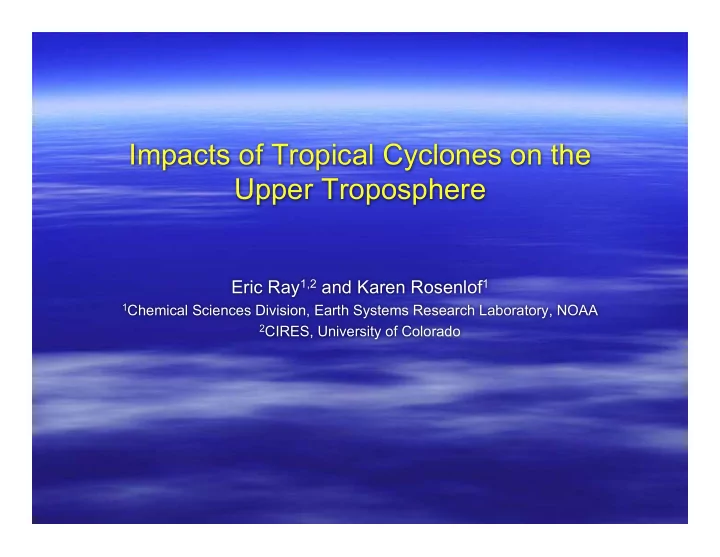

Impacts of Tropical Cyclones on the Upper Troposphere Eric Ray 1,2 and Karen Rosenlof 1 1 Chemical Sciences Division, Earth Systems Research Laboratory, NOAA 2 CIRES, University of Colorado
Impacts of Tropical Cyclones on the Upper Troposphere Using AIRS Products Eric Ray 1,2 and Karen Rosenlof 1 1 Chemical Sciences Division, Earth Systems Research Laboratory, NOAA 2 CIRES, University of Colorado
Motivation Why look at the impacts of TCs on the UT? TCs are potentially significant sources of trace gases and humidity to the UT through deep convection. The tropical UT plays an important role in the thermodynamic and radiative balance of the atmosphere. Changes in TC strength or number in future may produce feedbacks on climate.
Convection in tropical cyclones CloudSat View of Typhoon Prapiroon Eye • Tens to hundreds of kms in horizontal extent. • Deepest near the eye. • Multiple convective bands spiraling away from eye. • Large scale outflow region in UT.
Tracks of Tropical Cyclones Number of cyclones used in this study (Sep. 2002 to Oct. 2006) Intense Weak Atlantic 20 54 West Pacific 47 56 East Pacific 12 53 Intense = category 3-5 South Pacific 16 12 Weak = TS - category 2 South Indian 21 45
Data AIRS Primarily version 4, level 3 water vapor, cloud fraction and cloud top height. Have started to use version 5 water vapor, cloud properties, CO and CH 4 . MLS Version 1.51 water vapor
Hurricane Dennis July 9, 2005 Averages are taken in a cyclone eye centered coordinate system
Cyclone-Centered AIRS and MLS Averages AIRS MLS Ray and Rosenlof, 2007
AIRS Average Water Vapor Differences From Monthly Means Atlantic 173 hPa 2002-06 Large region of enhanced WV to the east of the eye. But also a compensating region of low water to the west of the eye.
AIRS Average Water Vapor Differences From Monthly Means West Pacific 173 hPa 2002-06 Larger region of enhanced WV compared to Atlantic.
AIRS Average Water Vapor Differences From Monthly Means South Pacific 173 hPa 2002-06 Region of enhanced WV is larger and values higher compared to NH TCs.
Probability Distributions of AIRS Water Vapor Differences West Pacific 173 hPa 2002-06 Basin Non-TC PDF includes days when a TC is not present from May-Nov in the West Pacific basin (110-180W, 0-30N)
AIRS Cloud Fraction Differences West Pacific 2002-06 Intense Weak Higher probability of more clouds during TCs. Opposite of the “Iris effect”
AIRS v5 Coarse Cloud Fraction Differences High Level 2004-05 Large region of compensating decrease in high level cloudiness to the west of the cyclone centers.
AIRS v5 Relative Humidity Differences 223 hPa 2004-05
Time Evolution of Water Vapor Enhancement 223 hPa Averages taken from 15 degree box around the eye each day.
AIRS and MLS Water Vapor Difference Profiles 2004-5 Intense Cyclones Ray and Rosenlof, 2007
Significance to Tropical UT Water Vapor Budget? May-October Compare the TC contributions to total tropical UT (300-150 hPa) water vapor by: F i = � i A i D i � T A T D T where i = individual TC region � = water vapor mixing ratio A i = area around the eye (15˚ box) November-April A T = area of the tropics (25˚S- 25˚N) D i = average cyclone days in season D T = 182 days
Summary • TCs effectively moisten and increase the cloud cover in the tropical UT. • They appear to be a significant contributor to the global tropical UT WV budget. • Warmer SSTs are likely to increase TC climate impacts.
Recommend
More recommend